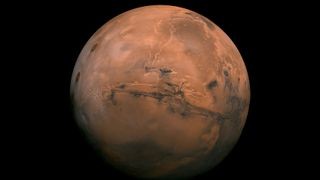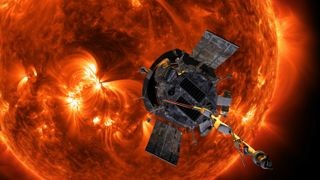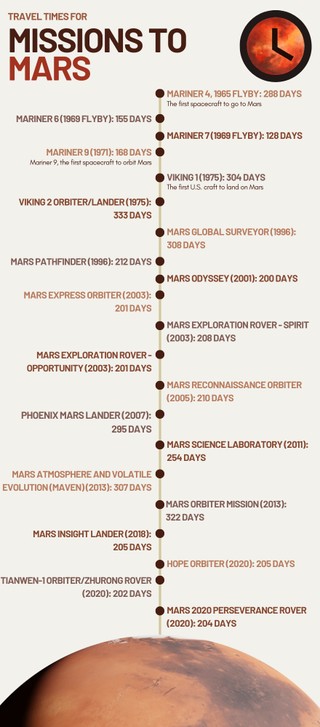Have you ever gazed at the night sky and wondered about humanity’s next giant leap – a journey to Mars? The Red Planet has captivated our imaginations for centuries, and the prospect of sending humans there is becoming increasingly real. You might have heard that a one-way trip to Mars could take around nine months, with a return journey stretching to about three years. But the simple answer of “nine months” only scratches the surface. The actual duration of a voyage to Mars is a complex equation, influenced by a fascinating interplay of orbital mechanics, technological capabilities, and mission objectives. In this article, we’ll break down the key factors that determine How Long Does It Take To Travel To Mars, delving into the science and engineering that will shape humanity’s interplanetary future.
Martian Miles: Understanding the Distance to Mars
To truly grasp the complexities of Mars travel time, we first need to understand the dynamic distance between Earth and Mars.
Ever-Changing Distance
Mars is our next-door planetary neighbor, but don’t imagine a short hop across the cosmic street. As the fourth planet from the Sun, Mars’ distance from Earth is far from constant. Both planets are in continuous motion, orbiting the Sun at different speeds and distances. Think of it like two cars on different lanes of a racetrack – sometimes they are close, and sometimes they are on opposite sides of the track.
Closest and Farthest Points
In an ideal scenario, if Mars were at its closest point to the Sun (perihelion) and Earth were at its farthest (aphelion), they could be a mere 33.9 million miles (54.6 million kilometers) apart. While this theoretical minimum distance is intriguing, it has never been observed in recorded history. The closest recorded approach occurred in 2003, with the two planets separated by a still considerable 34.8 million miles (56 million km).
Conversely, when Earth and Mars find themselves at their farthest points from the Sun and on opposite sides of it, the gulf between them expands dramatically, reaching up to 250 million miles (401 million km).
Average Distance
Despite these fluctuating extremes, the average distance between Earth and Mars is around 140 million miles (225 million km). This average figure gives us a useful benchmark for understanding the scale of the journey.
 Image of Mars against the black backdrop of space. The planet is a rusty red color.
Image of Mars against the black backdrop of space. The planet is a rusty red color.
Mars as seen from space, highlighting its rusty red color and the vastness of space.
Light Speed to Mars: A Matter of Minutes (Theoretically)
To put these vast distances into perspective, let’s consider the ultimate speed limit in the universe: the speed of light. Light travels at a phenomenal pace of approximately 186,282 miles per second (299,792 km per second). If we could instantaneously transmit a beam of light from Mars to Earth (or vice versa), how long would it take?
- Closest Possible Approach: Light would bridge the gap in a mere 182 seconds, or just over 3 minutes (3.03 minutes).
- Closest Recorded Approach: Slightly longer at 187 seconds, or 3.11 minutes.
- Farthest Approach: At the maximum distance, light would take 1,342 seconds, or about 22.4 minutes to travel between the planets.
- On Average: Across the average distance, light would make the journey in 751 seconds, or roughly 12.5 minutes.
While these light-speed travel times are astonishingly short, especially compared to the months-long reality of spacecraft travel, they underscore the immense distances involved in even reaching our closest planetary neighbor.
Current Spacecraft Speeds and Mars Travel Time
Of course, we can’t currently travel at the speed of light. So, what happens when we consider the fastest spacecraft humans have built?
Parker Solar Probe Example
The current speed champion is NASA’s Parker Solar Probe. Designed to study the Sun up close, this probe has repeatedly broken its own speed records. In December 2024, it achieved a mind-boggling top speed of 430,000 miles per hour (692,000 km per hour) during its 22nd solar flyby.
 Graphic illustration shows the Parker Solar Probe in front of the blazing sun.
Graphic illustration shows the Parker Solar Probe in front of the blazing sun.
An artist’s depiction of NASA’s Parker Solar Probe approaching the Sun, the fastest spacecraft ever created.
Travel Time Calculations Based on Parker Solar Probe Speed
If we could hypothetically equip a spacecraft with the Parker Solar Probe’s engine and send it on a direct, straight-line trajectory to Mars at that peak speed, the travel times would be:
- Closest Possible Approach: A swift 78.84 hours, or approximately 3.3 days.
- Closest Recorded Approach: Slightly longer at 80.93 hours, or about 3.4 days.
- Farthest Approach: A more substantial 581.4 hours, or 24.2 days.
- On Average: Around 325.58 hours, or 13.6 days.
Even at the blistering speeds of the Parker Solar Probe, a trip to Mars still takes days or weeks, not minutes. This highlights the immense energy required to achieve such velocities and sustain them over interplanetary distances.
Expert Insights: Factors Influencing Mars Travel Time
To gain a deeper understanding of the complexities of Mars travel time, we turn to an expert in the field. Michael Khan, a Senior Mission Analyst at the European Space Agency (ESA), offers valuable insights into the factors that truly dictate the duration of these interplanetary voyages.
The Energy Equation
According to Khan, the crucial factor determining travel time is “energy.” In the context of space travel, “energy” encompasses the power of the launch vehicle, the maneuvers executed by onboard rocket motors, and the amount of propellant consumed. Efficient spaceflight is essentially a careful and clever management of energy resources.
Hohmann Transfer and Pork Chop Plots
For journeys within Earth’s vicinity, like trips to the Moon, mission planners often consider trajectories like the Hohmann transfer – a fuel-efficient route, but only under specific conditions and for shorter durations.
However, Mars missions are inherently interplanetary transfers, meaning spacecraft must navigate orbits around the Sun. The complexity increases due to Mars’ elliptical orbit, its orbital plane’s inclination relative to Earth’s, and its longer orbital period around the Sun.
To navigate these complexities, trajectory experts use “pork chop plots.” These diagrams visualize optimal launch and arrival dates, along with the energy expenditure required for different Mars transfer opportunities.
Launch Windows and Transfer Durations
Pork chop plots reveal that launch windows for Mars missions occur roughly every 25-26 months. These windows offer different classes of transfers: faster options taking around 5-8 months and slower, more energy-efficient routes lasting 7-11 months. While longer transfers exist, the focus is typically on these shorter durations.
Khan notes a useful rule of thumb: “the transfer to Mars takes around as long as the human period of gestation, approximately 9 months.” However, he emphasizes that this is merely an approximation, and precise calculations are necessary for specific launch dates.
Landing vs. Flyby Missions
The mission objective also significantly impacts travel time. Spacecraft intended to orbit or land on Mars face stricter constraints compared to flyby missions. Orbiters require substantial propellant for orbit insertion, while landers need robust heat shields to withstand atmospheric entry. These factors necessitate limiting arrival velocities at Mars, often leading to Hohmann-like trajectories and consequently, longer travel times.
The Realities of Mars Travel Time Calculation
Our initial calculations, while illustrative, are based on simplified assumptions, primarily straight-line distances between planets. In reality, spacecraft don’t travel in straight lines. They follow curved trajectories, orbiting the Sun.
Orbital Paths and Moving Targets
A direct, straight-line path between Earth and Mars at their farthest separation would involve a perilous journey through the Sun – clearly not feasible. Spacecraft must follow orbital paths within the solar system.
Furthermore, the planets are constantly moving. Engineers must account for the planets’ orbital motion, aiming for Mars’ predicted location at the spacecraft’s arrival, not its position at launch. It’s akin to hitting a moving target from a moving vehicle.
Velocity Adjustments for Orbit Insertion
If the goal is to orbit or land on Mars, spacecraft cannot simply travel at maximum speed. They must decelerate upon arrival to execute orbit insertion maneuvers successfully. Arriving too fast would mean overshooting the destination.
Launch Windows and Mission Duration
NASA’s Goddard Space Flight Center indicates that an ideal launch alignment can facilitate a Mars journey in approximately nine months. Physics professor Craig C. Patten explains the orbital mechanics: Earth orbits the Sun in one year, Mars in about 1.9 years (roughly 2 years). A Mars transfer orbit is elliptical, longer than Earth’s but shorter than Mars’. Averaging these orbital periods suggests a 1.5-year elliptical orbit duration.
However, due to Mars’ orbital movement during the journey, launch windows – periods when Earth and Mars are favorably aligned – only occur every 26 months. This 26-month cycle dictates the timing of Mars missions.
While increasing fuel consumption could shorten travel time, current technology makes this approach less practical.
Future Technologies and Faster Mars Trips
Technological advancements hold the key to reducing Mars travel times in the future.
Space Launch System (SLS)
NASA’s Space Launch System (SLS), a powerful new rocket, is poised to become the workhorse for future deep-space missions, including crewed Mars missions. SLS promises increased payload capacity and potentially faster transit times.
Photon Propulsion (DEEP-IN)
More revolutionary concepts like photon propulsion could drastically shorten interplanetary journeys. Directed Energy Propulsion for Interstellar Exploration (DEEP-IN), spearheaded by physicist Philip Lubin, proposes using powerful lasers to propel spacecraft to velocities approaching the speed of light. Lubin suggests this technology could send a robotic spacecraft to Mars in a mere three days.
While still under development, photon propulsion and similar advanced technologies offer a glimpse into a future where Mars travel could become significantly faster.
Historical Mars Mission Durations
Looking back at past Mars missions provides real-world examples of travel times.
 Timeline of missions to Mars.
Timeline of missions to Mars.
A timeline infographic illustrating the duration of various historical missions to Mars, including their launch dates.
Historical missions, as illustrated in the infographic, demonstrate a range of travel times depending on mission type, launch window, and trajectory. These real-world examples underscore the variability inherent in Mars voyages.
Conclusion
So, how long does it take to travel to Mars? The answer, as we’ve explored, is not a simple number. It’s a complex interplay of distance, spacecraft speed, orbital mechanics, and mission objectives. While current technology typically translates to journeys of several months, future advancements promise to shrink those durations significantly. As we continue to push the boundaries of space exploration, the dream of a faster, more accessible journey to the Red Planet moves closer to reality.
